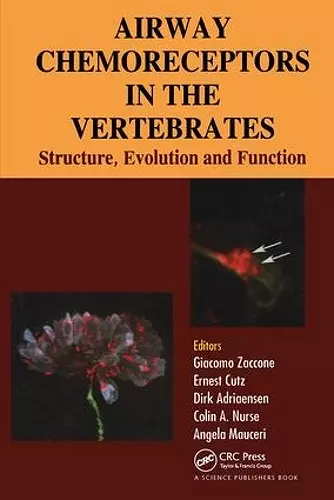Airway Chemoreceptors in Vertebrates
Format:Hardback
Publisher:Taylor & Francis Inc
Published:9th Jan '09
Currently unavailable, and unfortunately no date known when it will be back

This book provides a comprehensive and up-to-date account of the information available on the morphological, physiological and evolutionary aspects of specialized cells distributed within the epithelia of the airways in the vertebrates. A lot of work has been done on the cell and molecular biology of these cells which are regarded as as oxygen receptor neuroepithelial cells. These chemoreceptors which were conserved throughout evolution have neuroendocrine functions carrying their signals to the central nervous system.
The chemoreceptor cells are sensors which detect the signal changes in the external and internal environments, and play a key role in the survival of various species. Studies addressed to the chemoreceptor cell systems in the airways are of great importance for investigating their response to changes in the oxygen and carbon dioxide concentrations in the environment since the future of the planet earth is being threatened by global warming and climate change.
Praise for the book:
…This volume would be of special interest to researchers who are curious about the evolution of vertebrate respiratory control in general and the regulation of ventilation in nonmammalian vertebrates in particular. —Wayne L. Silver, Wake Forest University, in The Quarterly Review of Biology, Volume 85, Number 2
This book provides a review of the chemoreceptive cells associated with vertebrate respiration. … Most of the cells described in this volume detect respiratory gases and function to help regulate ventilation. Other roles include immune system activation, defense against bacteria, and environmental chemical detection. The majority of the book looks at the anatomy of respiratory-related structures: lungs (gills), carotid labyrinths (carotid body), and respiratory passages. … There are five sections organized by vertebrate class (fish, amphibians, reptiles/birds, and two for mammals). …This volume would be of special interest to researchers who are curious about the evolution of vertebrate respiratory control in general and the regulation of ventilation in nonmammalian vertebrates in particular. —Wayne L. Silver, Wake Forest University, in The Quarterly Review of Biology, Volume 85, Number 2
This book provides a review of the chemoreceptive cells associated with vertebrate respiration. … Most of the cells described in this volume detect respiratory gases and function to help regulate ventilation. Other roles include immune system activation, defense against bacteria, and environmental chemical detection. The majority of the book looks at the anatomy of respiratory-related structures: lungs (gills), carotid labyrinths (carotid body), and respiratory passages. … There are five sections organized by vertebrate class (fish, amphibians, reptiles/birds, and two for mammals). …This volume would be of special interest to researchers who are curious about the evolution of vertebrate respiratory control in general and the regulation of ventilation in nonmammalian vertebrates in particular. —Wayne L. Silver, Wake Forest University, in The Quarterly Review of Biology, Volume 85, Number 2
ISBN: 9781578086146
Dimensions: unknown
Weight: 1020g
464 pages